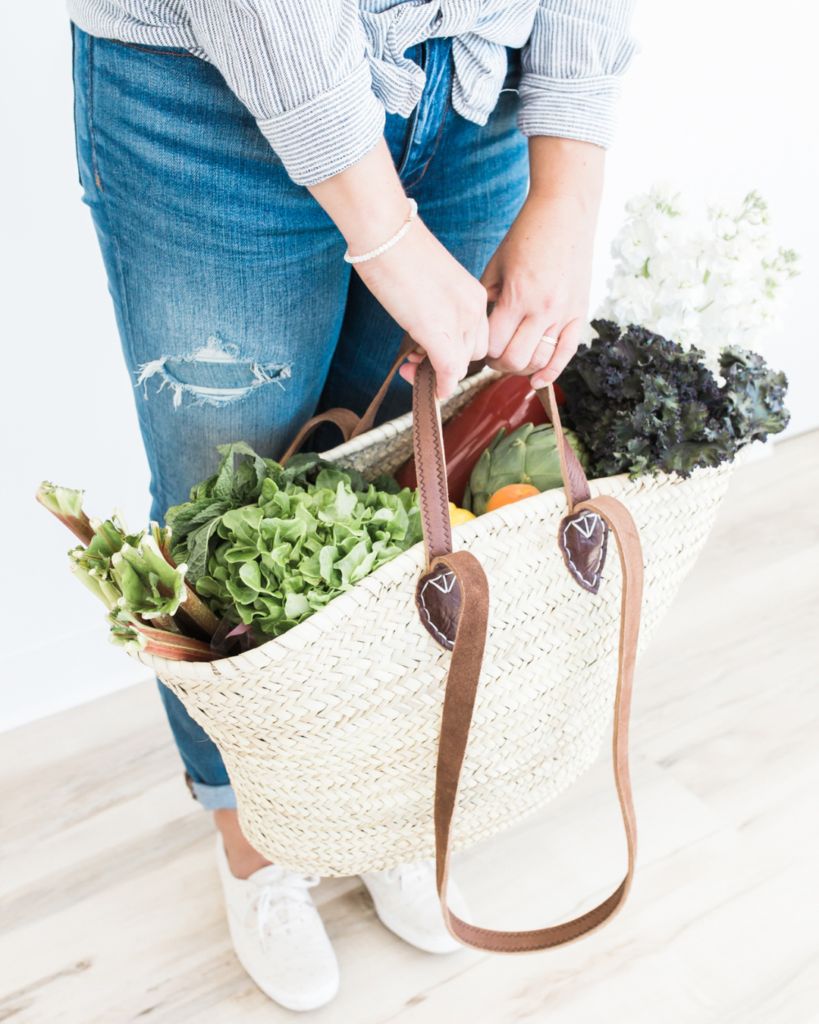Episode 2 Transcript
Have you wanted to use organic or non-toxic products but felt like they were just too expensive? I totally get it. Sometimes it seems like the only options are either to spend a fortune on these products, or to settle for cheaper conventional alternatives, or by spending hours in the kitchen DIY-ing it.
But the good news is that there are plenty of ways to save money on organic and non-toxic products more affordable. I’m going to go through some of my favorite money-saving tips here, so just choose the ones that are most doable for you so that you can enjoy the benefits of using these safer products without breaking the bank.
Choose Your Top 2
My first tip is to choose your top two. So if you listened to the first podcast episode about three ways to go slightly greener, you’ll remember that this is about replacing just your top two or three foods that your family uses the most, or whatever favorite products you have, and just replacing those first with a healthier version.
For instance, if your child’s favorite food is hotdogs, just switch to a healthier brand like Applegate, and you can do this with almost anything. And this way you don’t feel like you have to replace everything all at once if you just start out with your top one or two or even three most used, most toxic products.
Buy Organic from the EWG’s Dirty Dozen List
The second way you can do this is to buy organic of the produce that’s listed on the Environmental Working Group’s Dirty Dozen List. These are the foods that have the highest levels of pesticides, so they should be bought organic  as often as possible, but if they’re either not available or you’re sticking to a budget, they also have a clean 15 list, which includes produce that have the lowest levels of pesticides and don’t necessarily need to be bought organic. Just remember that either way, buying whole foods and produce, whether it’s organic or not, is more healthy than not buying it at all.
as often as possible, but if they’re either not available or you’re sticking to a budget, they also have a clean 15 list, which includes produce that have the lowest levels of pesticides and don’t necessarily need to be bought organic. Just remember that either way, buying whole foods and produce, whether it’s organic or not, is more healthy than not buying it at all.
Buy Grocery Store Brands
You can also buy store brands because many grocery stores have their own brand of organic products that are often cheaper than name brand options. These brands have to adhere to the same organic requirements as name brand products, but they typically cost less because they don’t have the same marketing costs associated with them. So you’re not paying for labels and marketing and, for example, you can look for Whole Foods that has the 365 brand or Target that has Simply Balanced. You can also check your store’s policy on stacking coupons. You can download coupons from the store’s website and look for coupons online or in your local paper for that same product because some stores will honor double coupons.
Buy in Bulk
Buying in bulk is another great way to save money on organic products. Many grocery stores offer discounts when you buy larger quantities of items like grains, nuts and dried fruits, and you can also save money by purchasing large bags of organic rice and beans instead of the smaller packages. Or you can shop for your favorite organic and healthy foods at warehouses and membership club stores like Costco. Buying in bulk, especially in the bulk bins of the foods you frequently eat, can save a lot of money in the long run.
Don’t Buy Pre-Washed Produce
This next tip is short but sweet, but it’s don’t buy pre-washed produce like lettuce. It can cost almost twice as much, plus most likely you’ll rewash it anyway. Next, you can shop seasonally because produce that’s in season is often cheaper than out-of-season produce. You can plan your meals around what’s currently available to save money on fresh fruits and vegetables.
For example, in the summer months, you may find that tomatoes are usually less expensive than they are during the winter, especially depending on where you live. And seasonal foods also don’t have to travel as far, meaning that they keep more of their nutrients, and they will typically be cheaper. To find what’s in season in your area, use a website like seasonalfoodguide.org.
Join a CSA
You could also join a CSA. CSA stands for Community Supported Agriculture, and these programs allow you to purchase a share of a local farm’s harvest at the beginning of the season, which can be more affordable than buying individual items throughout the year. CSAs typically provide a variety of fresh fruits and vegetables each week throughout the growing season, and while they may seem more expensive at first because many of them are paid upfront, they’re usually cheaper in the long run.
And you can also grow your own, so you can consider starting a garden or growing herbs in pots to save money on fresh produce and spices or herbs. Even if you don’t have much space, you can grow some herbs or small vegetables like cherry tomatoes in containers.
Freeze Leftovers
Freeze your leftovers. This way, you don’t let any food go to waste, and you might even have a handy meal in a pinch, but you can also freeze leftovers or excess produce to use later. So if you have extra berries or bananas that you know might go bad before you use them, or even for items like spinach, freeze them to use them for smoothies later on.
Make Your Own
Next up is make your own snacks and baked goods. Now, before you think I’m in my kitchen all the time creating all these beautiful baked goods and making my own snacks, I’m not. If you know me, you know I don’t love to cook, but the good thing is that there are so many recipes out there that are so easy and just take a few ingredients, things on Pinterest and TikTok. So just Google anything or search in any of those social media sites for recipes. 
Protein balls are so easy to make, things with organic oatmeal, snack bars. They take so few ingredients, and they’re so fun and easy to make. So instead of buying packaged snacks and all these other baked good packaged products, you can just make them yourself using organic ingredients. This not only saves money, but also allows you to control exactly what goes into your food.
How to Save Money on Cleaning Products
We’ve been talking mainly about food here, but there are other tips you can use for other items such as personal care products like shampoo and toothpaste, or even cleaning products. Because when it comes to cleaning products, it may seem like many of them are more expensive, which is what I hear most often. But the good thing about many non-toxic cleaners is that some of them are powdered or concentrated, meaning that you can use less to still get the job done. I love using a powdered laundry detergent like Molly’s Suds because it’s highly concentrated, and it lasts a long time, especially for us as a family of five. And it works better than most liquid detergents we’ve used.
You can also clean with things like castile soap or one of my favorites is Vermont Soap’s Liquid Sunshine Concentrate because all it takes is a couple teaspoon fulls or a couple squirts into warm water, and you can clean almost anything and it’s a great degreaser also. I found that you don’t have to use very much to get the job done.
Look for Coupons & Discounts
No matter what product you’re looking for, whether it’s foods, beverages, or cleaning products or personal care products and cosmetics, one thing you can do is find the companies that you like on social media sites such as Facebook or Twitter or Instagram and follow them there. They’ll often post coupons for their followers, or you can also go to their website and see if they have a pop-up to sign up for a newsletter, which typically also offers a percentage off. Some websites even have a link at the very bottom of their page that says discounts that you can click.
You can also Google the name of the company plus the word coupons and see if anything pops up there. For example, you can Google Badger Balm plus coupons, if nothing comes up, again, sign up for their newsletter list. The company may send out occasional email deals and coupons.
Shop Membership and Discount Sites
You can also shop websites such as Vitacost and Amazon. You’ll get free shipping on Prime items if you are an Amazon Prime member, and Vitacost offers free shipping on orders over $49. Thrive Market is another great option. It’s a membership site, but you get up to 30% off their items plus exclusive deals just for members, and they have a lowest price guarantee. All right, that was a lot, but I hope you found some of these tips here that you can use. But most importantly, you can see that it is possible to eat healthy and use safer products while sticking within your budget.
